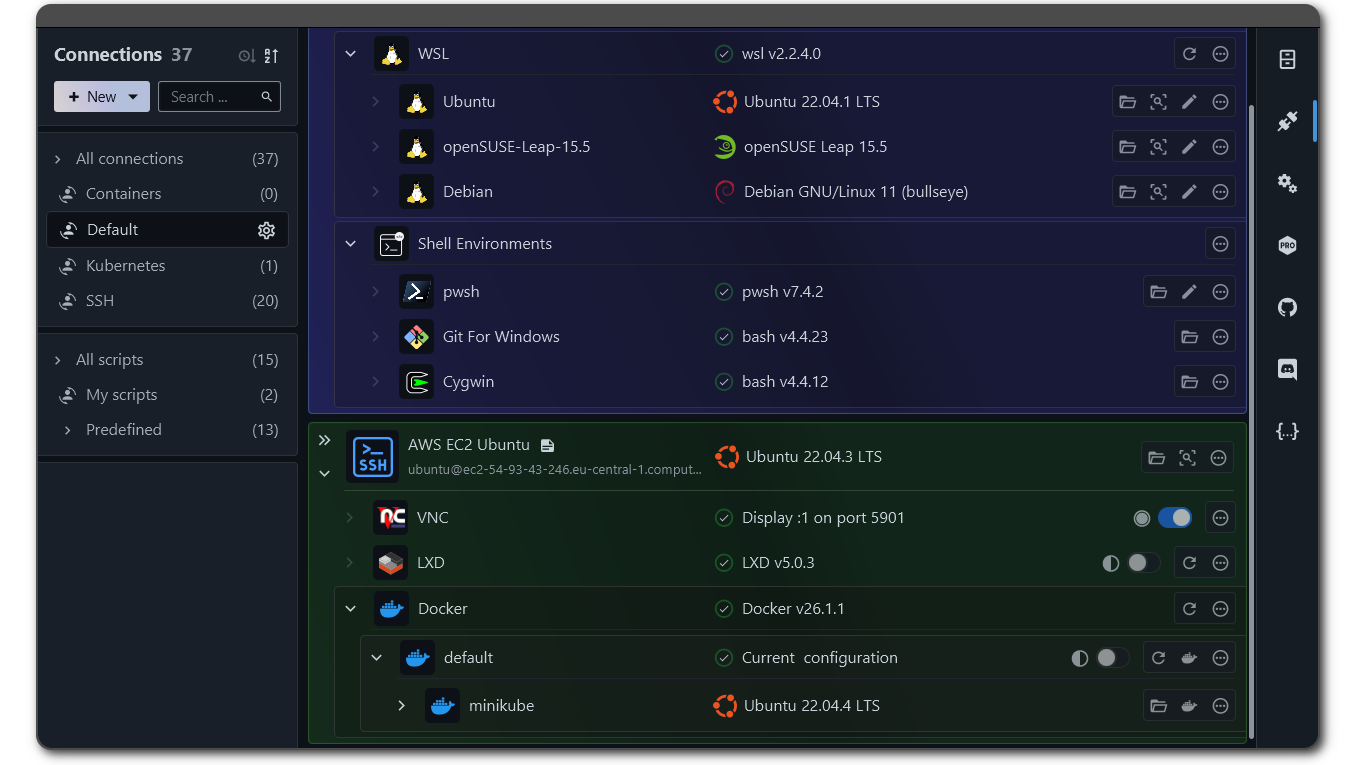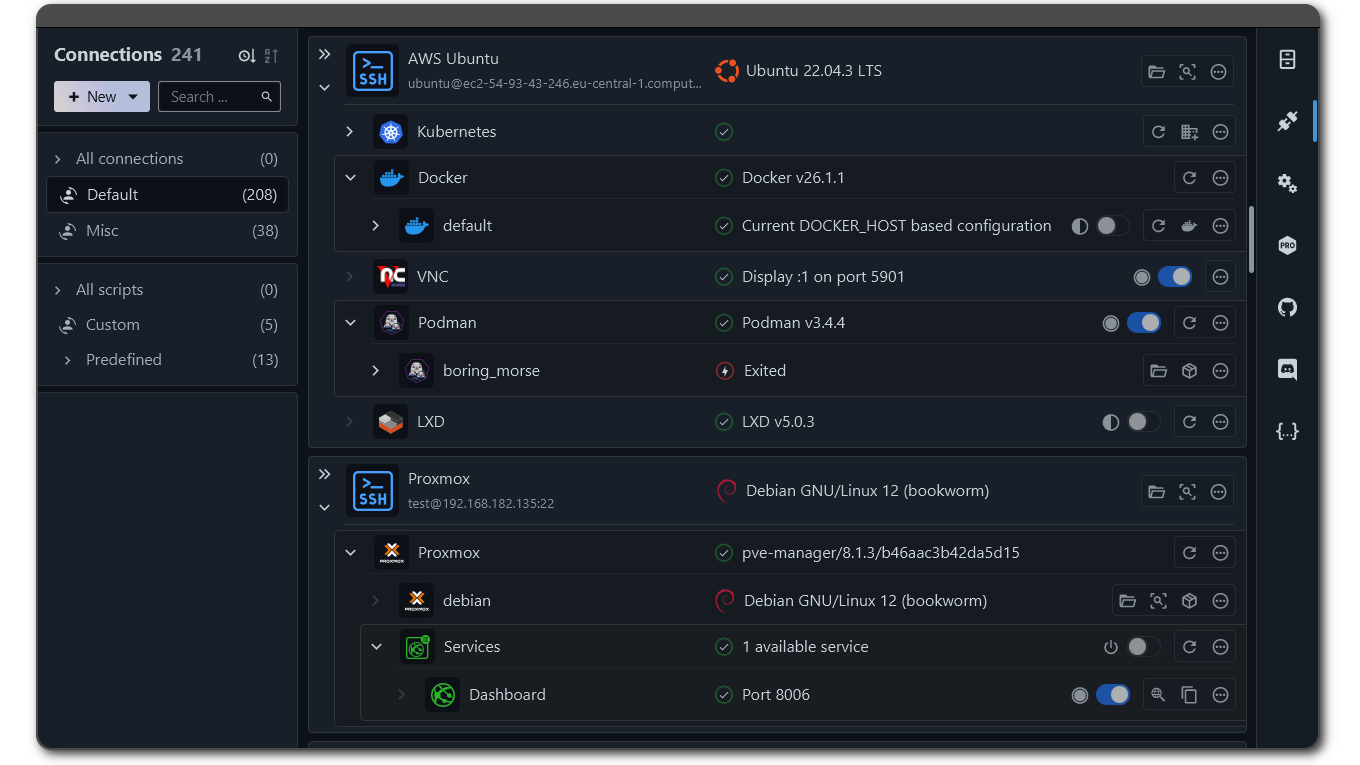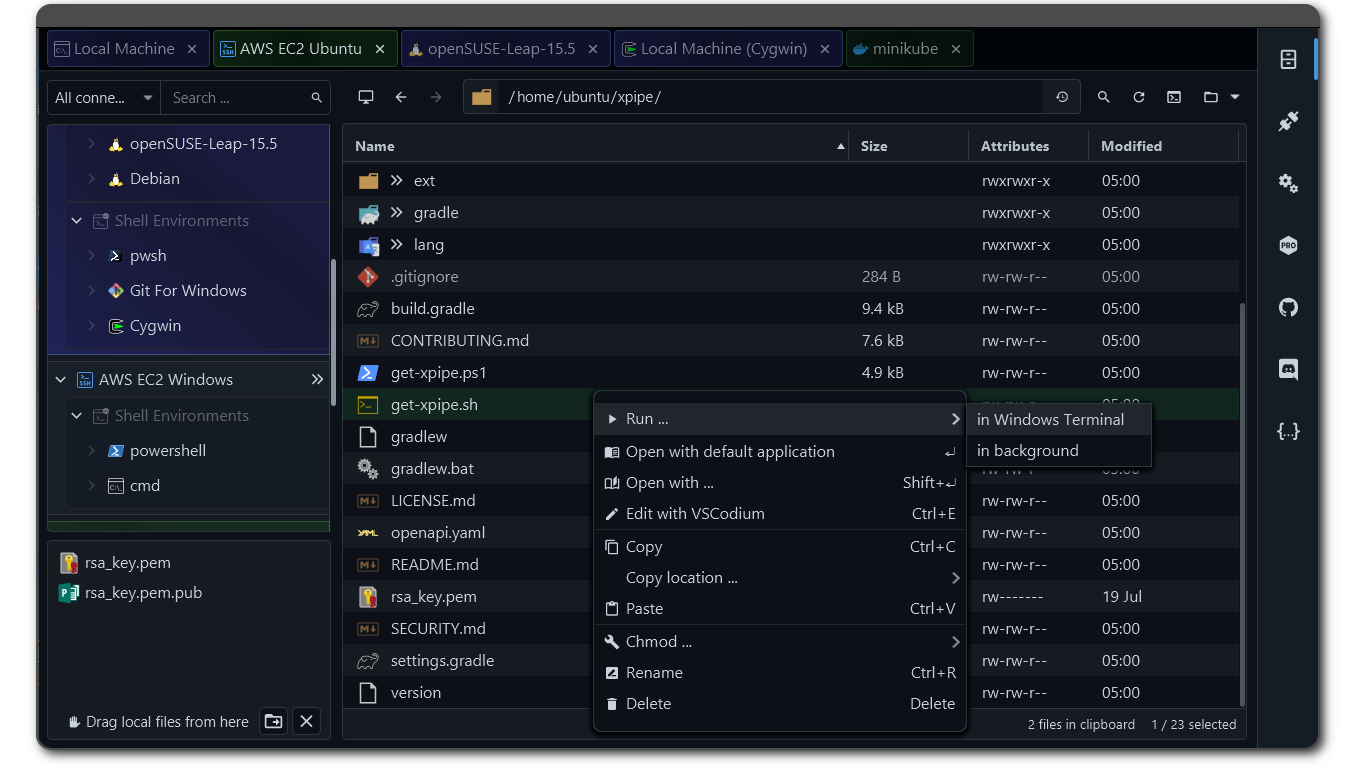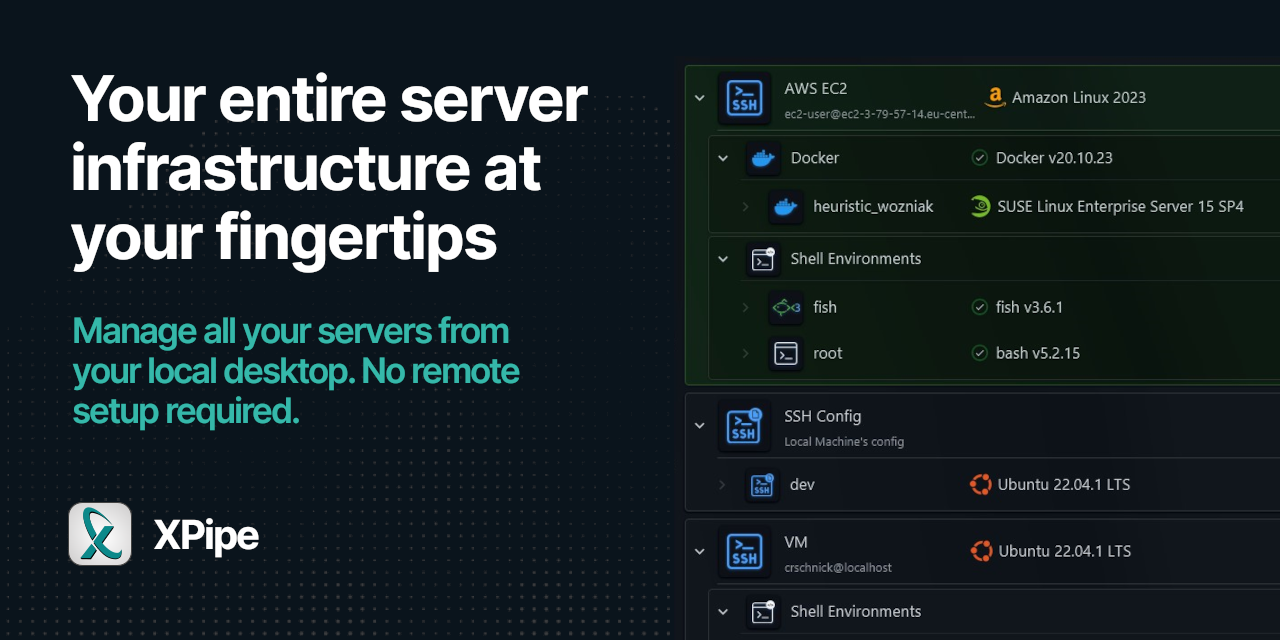from crschnick@sh.itjust.works to selfhosted@lemmy.world on 21 Sep 2024 06:11
https://sh.itjust.works/post/25511511
I’m proud to share a major development status update of XPipe, a new connection hub that allows you to access your entire server infrastructure from your local desktop. It works on top of your installed command-line programs and does not require any setup on your remote systems. XPipe integrates with your tools such as your favourite text/code editors, terminals, shells, command-line tools and more.
Here is how it looks like if you haven’t seen it before:



More terminal integrations
There is now support to use the following terminals:
- Termius
- MobaXterm
- Xshell
- SecureCRT
These work via a local SSH bridge that is managed by XPipe. That way you can keep using your existing SSH terminal solution with the added functionality of XPipe.
Pricing model updates
I received plenty of user feedback, so I changed the old pricing model to one that should capture the demand better. The old pricing model was created at a time when XPipe had no customers at all and did not reflect the actual user demand. The main changes are the addition of a homelab plan, a new monthly subscription, and changes to the one-year professional edition. All changes only apply to new orders. The community edition is also not changed.
The homelab plan is essentially a cheaper alternative to the professional plan that should include all paid features necessary to operate XPipe in a typical larger homelab environment if the community edition is not enough. If you are looking for a detailed feature comparison of what is included in which plan, you can find that information at xpipe.io/pricing#comparision.
The old yearly plan differed from many established pricing models and required some bit of reading to fully understand. I think there were more people asking clarifying questions about it than actually buying it, which is not a good sign for a pricing model. And in the end, many customers who valued ownership of a product went for the lifetime variant anyway instead. So the pricing model has been changed to a more traditional subscription plan for monthly/yearly options, plus the already existing lifetime plan which stays the same. This makes it easier to understand for potential customers and hopefully easier to sell as well.
Hyper-V support
This release comes with an integration for Hyper-V. Searching for connections on a system where Hyper-V is installed should automatically add connections to your VMs. XPipe can connect to a VM via PSSession or SSH. PSSession is used by default for Windows guests if no SSH server is available on the guest. In all other cases, it will try to connect via SSH. Since Hyper-V cannot run guest commands on non-Windows systems from the outside, you have to make sure that an SSH server is already running in the VM in that case.
The Hyper-V integration is available starting from the homelab plan.
Teleport support
There is now support to add teleport connections that are available via tsh. You can do that by searching for available connections on any system which has tsh installed. This is a separate integration from SSH, SSH config entries for teleport proxies do not work due to tsh limitations and are automatically filtered out. The new implementation solely works through the tsh tool.
This feature is available in the Professional plan as Teleport is typically an enterprise tool.
VNC improvements
The VNC integration has been reworked. It now supports more encrypted authentication methods, allowing it to connect to more servers. Furthermore, it is also now possible to create VNC connections without an SSH tunnel for systems that do not have SSH connectivity. You can also now send CTRL+ALT+DEL via SHIFT+CTRL+ALT+DEL.
Experimental serial connection support
There is now support to add serial connections. This is implemented by delegating the serial connection to another installed tool of your choice and opening that in a terminal session.
Note that this feature is untested due to me not having physical serial devices around. The plan for this feature is to evolve over time with user feedback and issue reports. It is not expected that this will actually work at the initial release. You can help the development of this feature by reporting any issues and testing it with various devices you have.
TTYs and PTYs
Up until now, if you added a connection that always allocated pty, XPipe would complain about a missing stderr. This was usually the case with badly implemented third-party ssh wrappers and proxies. In XPipe 11, there has been a ground up rework of the shell initialization code which will allow for a better handling of these cases. You can therefore now also launch such connections from the hub in a terminal. More advanced operations, such as the file browser, are not possible for these connections though.
Scripting improvements
The scripting system has been reworked to make it more intuitive and powerful. You can now call a script from the connection hub directly for each connection. You can also now launch scripts either in the background or in a terminal if they are intended to be interactive. In the file browser, when multiple files are selected, you can now call a script with all the selected files as arguments.
Other
There have also been a lot of improvements and bug fixes across the board that are not listed here. The workflow has been streamlined, the Proxmox support has been refined, and the git sync has been made more robust.
The XPipe python API has now been designated the official API library to interact with XPipe. If you ever thought about programmatically interacting with systems through XPipe, feel free to check it out.
The website now contains a few new documents to maybe help you to convince your boss when you’re thinking about deploying XPipe at your workplace. There is the executive summary for a short overview of XPipe and the security whitepaper for CISOs.
A note on the open-source model
Since it has come up a few times, in addition to the note in the git repository, I would like to clarify that XPipe is not fully FOSS software. The core that you can find on GitHub is Apache 2.0 licensed, but the distribution you download ships with closed-source extensions. There’s also a licensing system in place as I am trying to make a living out of this. I understand that this is a deal-breaker for some, so I wanted to give a heads-up.
Outlook
If this project sounds interesting to you, you can check it out on GitHub!
Enjoy!

#selfhosted
threaded - newest
This is something I’ve felt we’ve needed for a long time, but cloudscalers have their own environments that include resource management and beyond dev, if anything goes wrong they either reboot the net image or offline it for maintenance.
This is something I’ve wanted to throw together, will give it a try soon, could even be useful for development.
nice! ill give this a try tomorrow
I’ve been using this for awhile and it had a little learning curve coming from MobaXTerm, but it’s been great.
Looking over your licensing model, I noticed this
What do you classify as an ‘enterprise’ system? Is that any server OS, or just like a datacenter license or something?
This refers to having an enterprise license for Windows. If you have such a Windows product key enabled, the OS name will show as Windows Enterprise or as Windows Datacenter.
The goal is to just separate the users into personal and commercial customers, because you would have to spend quite a bit of money for these Windows licenses and keeping such systems running.
But in practice, you can just attempt to connect to any system from XPipe and it will tell you whether if you need a license for that.